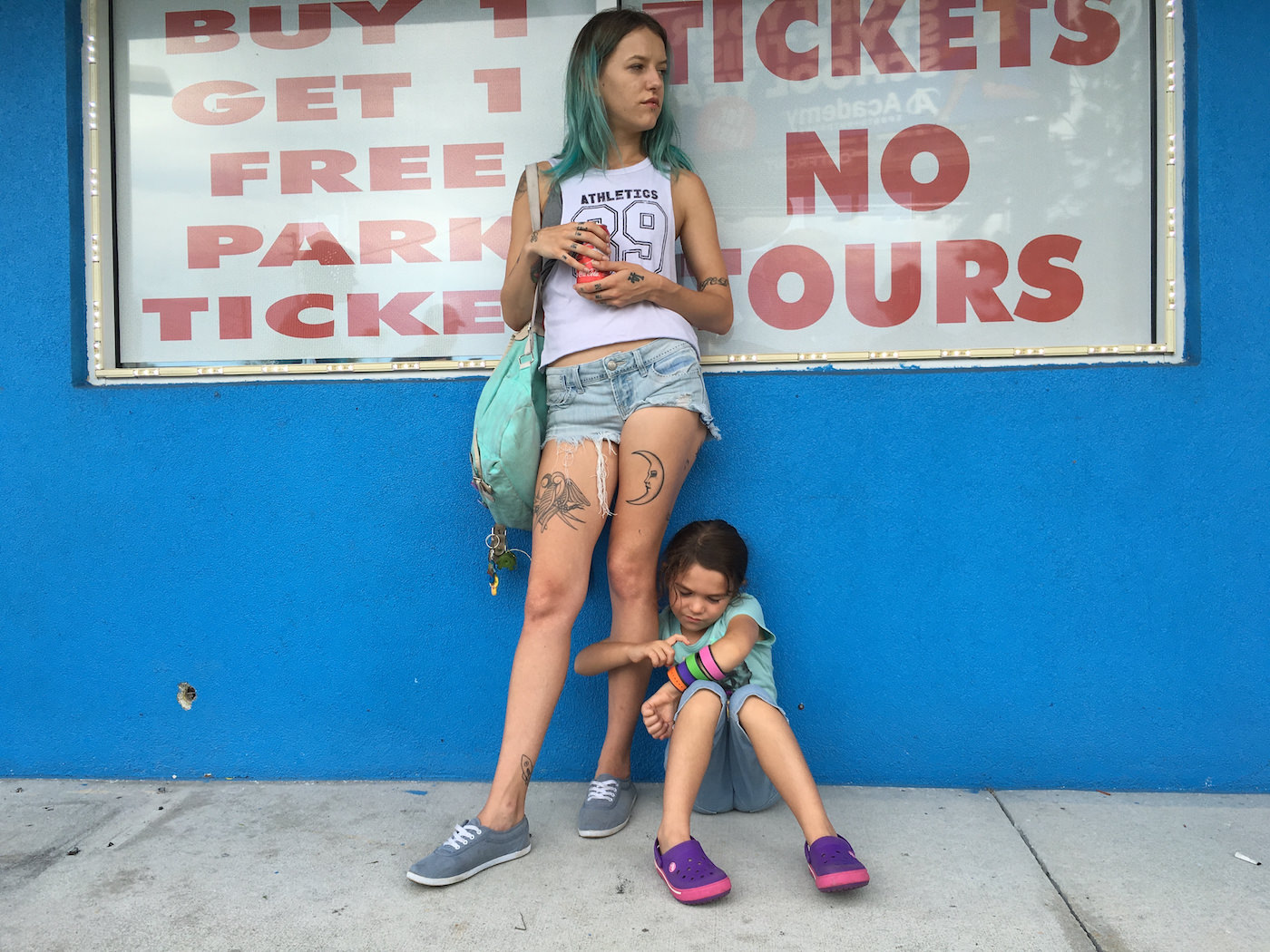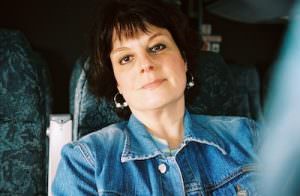The Florida Project’s Young Stars & Director Discuss Dazzling new Film
The Florida Project shows a side of Disney’s influence on the Sunshine State that tourists rarely see from inside the glittery artifice of the Magic Kingdom in Orlando. Namely, the economic reality of those struggling to make ends meet as they are forced to reside in the budget motels populating roadside areas beyond the theme park.
Amazingly, the film offers an often upbeat view of this lifestyle since filmmaker Sean Baker — who made a splash by shooting his previous effort, Tangerine, entirely on an iPhone — allows the audience to see the spooky abandoned buildings, overgrown junk-strewn fields and garishly kitschy souvenir shops through the eyes of children. The Magic Castle, a real-life purple-hued motel, offers a personal Adventureland for mischievous 6-year-old Moonee (Florida native Brooklynn Prince), who lives with her struggling 22-year-old single mom, Halley (New York-based Bria Vinaite), and hangs with pals Scooty (Christopher Rivera) and Jancey (Valeria Cotto). The tykes spend their days trying to score free ice cream, pulling pranks such as shutting down the motel’s power supply and pestering the stern yet caring motel manager Bobby (Willem Dafoe, going against type in an award-worthy performance).
Baker, 47, alongside leading ladies Prince, 7 and Vinaite, 24, discusses how he approaches what he likes to call his pop-verite style of cinema, which allows for ad libs and unexpected events to find their way onto the screen. He also discusses whether he has heard from Disney yet as the movie is about to open on Friday, especially about the closing shot of a familiar iconic image.
Brooklynn, it seemed like you got to ad lib a lot as you ran around the motel and played with friends. How did you get into your character?
Prince: Yes, I did. I just thought about what Moonee would do. I just did it. And it worked out for me. I hung out with some kids from the motel to see how crazy they act and what fun they had so I had all that information to use.
This is your first movie, Bria. But you have done some already, Brooklynn.
Prince: I’ve been acting since I was 2.
What was your first movie?
Prince: It was Robo-Dog.
How was Sean as a director? What makes him special?
Prince: Compared to other directors? He’s great. He is better than the others. And it’s just a pleasure to work with him. I am so blessed. He was so nice and patient. Sometimes the kids would be rambunctious. But it was summer, what do you expect? And he would be chill about it. He would wait for Sam (Quan, the children’s acting coach) to handle it. Or, he would be like, “Kids, come over here. Stop being rambunctious.”
How about you, Bria?
Vinaite: I got so lucky, because it was my first time being on a set. And to have someone who believed in me so much and was so helpful throughout the whole process – anytime I felt like there was a little word I wanted to tweak or just say a sentence differently, Sean was open to that. He made me feel so comfortable and that I could do a good job. That helped me have the confidence in myself to do a good job.

Bria Vinaite and Brooklynn Prince. Photo by Marc Schmidt, courtesy of A24
I looked up The Magic Castle on Trip Advisor. It’s $38 a day now. Three dollars more than in the movie. The online reviews were mixed. But you didn’t make it look that bad.
Baker: They actually have been through harder times. There is a beautification process going on along Route 192. When we chose the location, it was slightly grungier. Then they painted it and I lost my mind. But then I thought, “This just might work.” We worked that in when Willem is with Caleb Landry Jones as Bobby’s son. He says, “I like the purple. How much did that cost?” What we try to do is take a little bit of real life and put it into the film. For example, the helicopter port was there. We knew it would interfere all the time so instead we worked it in.
Your movies often employ that sort of found art. You go with the flow. Probably not many directors like to work that way. When Christopher Nolan made Dunkirk, I don’t think he was winging it that much. But if an accident happens, you work it in.
Baker: You roll with it. It could be better than what you have on the page.
It is interesting that you wanted the kids to be inspired by the Little Rascals shorts that were popular during the Depression era. When I watched them on TV growing up, I was disappointed by the lack of girls in the gang
Baker: I never thought of it that way. A lot of the shorts I was influenced by were from the ‘20s and ‘30s, when Spanky was younger and it was Hal Roach in charge. You are right, there were mostly boys.
Prince: There was Darla. She’s my favorite.
Baker: It wasn’t until I got a little bit older, where I started looking at those in a different light. The fact they were set against the Great Depression and a lot of the kids were living in poverty. But it was still about their joy and about their humor.
Your writing partner, Chris Bergoch, is the one who was familiar with this area of Florida because his mom moved to Kissimmee. You both went down there to do research and talk to people.
Baker: When we first started, back in 2011, there were a few more motels that were basically rip-offs to a certain degree of what was going on in Disney and the park.
You decided to shoot on real anamorphic 35mm film and not digital? Why?
Baker: Many reasons. I’m in a weird place where I’m known for the iPhone and how it inspired and helped people the way the Dogme 95 movement helped me. At the same time, film has to be fought for to be kept alive. So I am fighting for both mediums. All I can say is this, you can find beauty in both and it really depends on the project. For this one, No. 1, I didn’t want to be known as the iPhone guy. Also, there is that organic quality of celluloid that you can’t match with digital. I was dealing with nostalgia to a certain degree because I wanted people to remember their own childhood.
I think my favorite scene is at nighttime, when Moonee and her mom are celebrating Jancey’s birthday with a candle in a cupcake and the fireworks going off.
Baker: That’s a nightly event at the parks. There are vantage points from outside the parks. And from The Magic Castle itself, you can see them glow. At the beginning of the movie, I don’t know if you noticed, but Willem is smoking a cigarette as the motel lights come on and you can hear the fireworks in the background.
I love that you included all these tourist traps shaped like an orange, a wizard, a giant ice cream cone and even one touting guns.
Prince: There was a gorilla, too.
Baker: We didn’t get to shoot in a real Waffle House. But I think we came kind of close. We found an old Waffle House. The interior looked like a Waffle House. It had yellow seats and everything.
Vinaite: But we called it Waffle Home.

Christopher Rivera and Brooklynn Prince. Photo courtesy of A24
Speaking of food, Brooklynn, how much ice cream did you get to eat while making the film?
Prince: About 45 cones.
Baker: After about the first week and a half, I think we switched over to sugar-free.
Did you all talk to residents to hear their stories?
Vinaite: I talked to a single mom, Ginger, who was living in a room with five other kids. And that was my first time seeing that. And she was so welcoming and so willing to share her story. And it really just opened my eyes. They were all so open to sharing their stories and really show us their day-to-day lives so we could portray these characters in the correct way.
Baker: Willem came in a week early and sat down and had a long talk with one gentleman who really was the guy who inspired the Bobby character. It was really great that he did that. It showed he was dedicated and wanted to understand the guy’s struggle. Then we gave him a spray tan.
Vinaite: Oh my God. Can I just say I remember him complaining to me one day. He was like, “I’ve been in Florida for all these weeks, and at the end of every week, my spray tan washes off and I don’t have a tan underneath.” I didn’t know this, but you can’t tan with a spray tan. He left really pasty and he was sad.
Did you hear about a honeymoon couple booking The Magic Castle thinking it was part of the Disney complex and getting upset over their mistake?
Baker: No. But people at film festivals have come up to me and said, “That happened to my family when I was 8.”
That topless old lady sunning by the motel pool , she reminded me of an Andy Warhol character with her blender pitcher filled with an alcoholic beverage by her side.
Baker: That was Sandy Kane. You talk about improv. Christopher, in that wide shot when they climb up on the balcony and go all the way around, as he’s running he says, “Remember the time she was dancing and fell in the pool?”
Sean found you on Instagram, Bria. Are you going to be the first Instagram star? Good-bye YouTube celebs.
Vinaite: I guess so. That’s my plan.
Baker: I still don’t know how I came across her. It was just completely random. The way she was very loose and confident on her video. She was just making me laugh. I knew we could pull things from her personality for the Halley character.
Another happy accident. I am just wondering if Disney has had anything to say to you, because they protect their brand like crazy. That last shot sort of takes liberties a bit even though it is perfect.
Baker: No, no, no. Not yet. I think what it comes down to is this. We aren’t pointing fingers with this film and we aren’t being disparaging towards the Disney name. What we are saying is that it is truly a children’s paradise. What I like to say and what is important, especially in the last two years, I’ve seen a real effort made by the local government and agencies, the philanthropists and, just in general , the community. That includes Disney. They have given $500,000 to the Homeless Impact Fund. I’m not trying to point fingers or make anyone a villain. If there is a villain, it is the recession of 2008.
Featured image: Bria Vinaite, Valeria Cotto, Brooklynn Prince. Photo by Marc Schmidt, courtesy of A24



